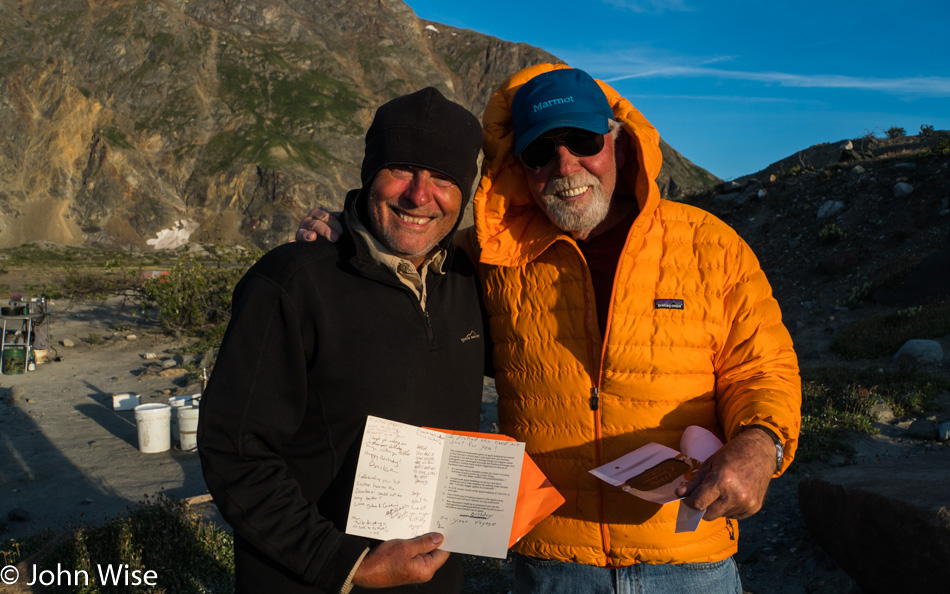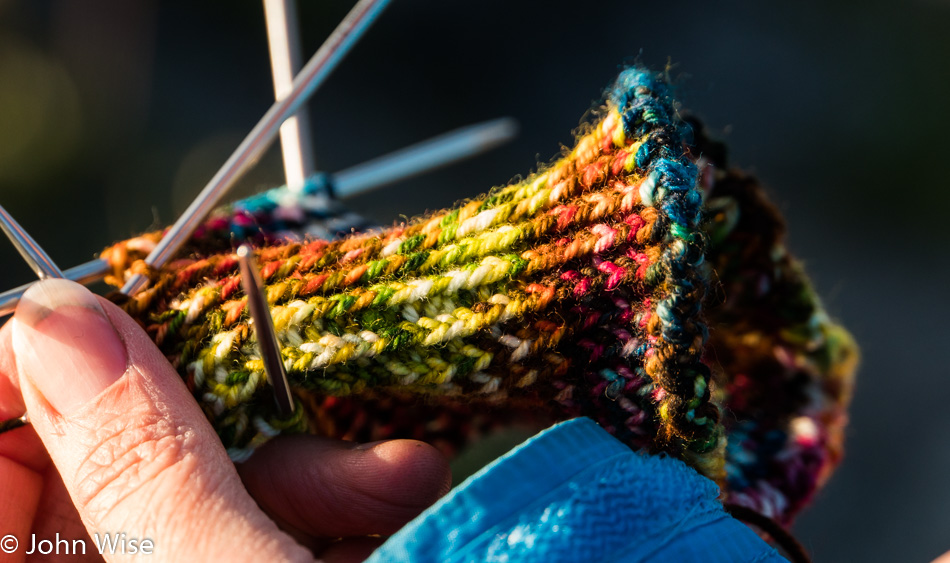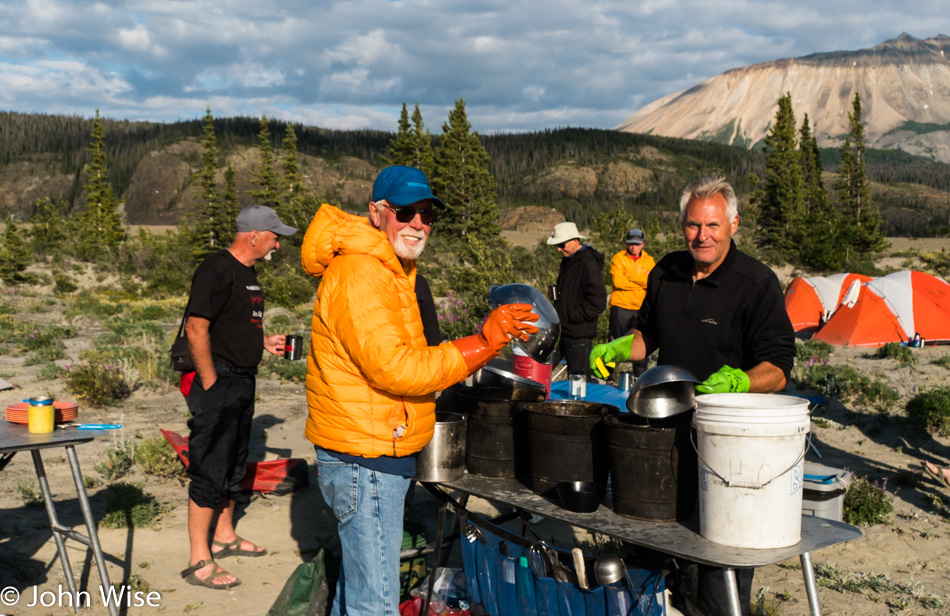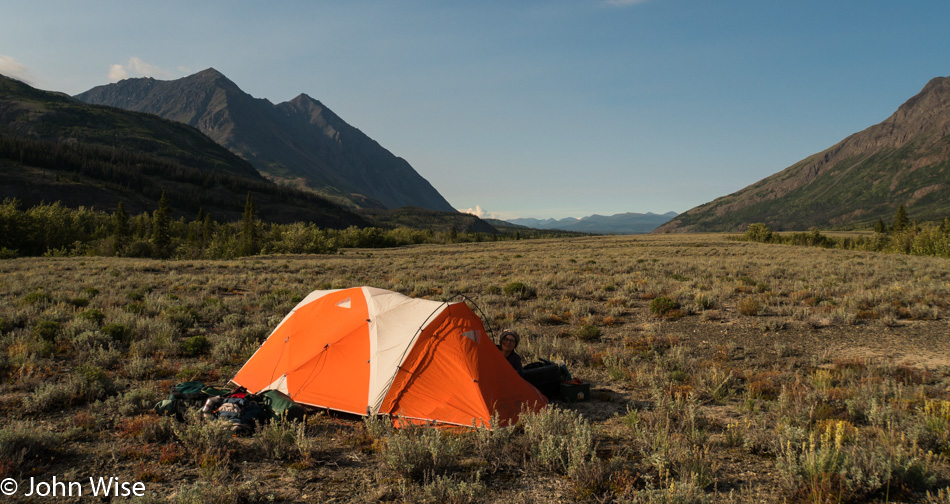
We woke early and started breaking down camp quickly. Breakfast was a slapdash of oatmeal and bagels followed by a faster-than-usual cleaning of the dishes, clearing away of the fire pits, and loading the boats, all to get out of town before the wind made an appearance.

We are getting out of town because Lava North is on today’s menu.

Whatever sightseeing I want to do will have to happen from the river; no time for lingering as big white water is beckoning.

Leaving Lowell Lake, we are following a different route than during our previous visit five years ago. There will be no stop to hike up the western terminal moraine of Lowell Glacier, no camping at Sam & Bill’s campsite where we had a near-encounter with a grizzly bear; we are heading directly to the scout location for what awaits us.

Rough-hewn earth is a constant companion down this river, as the Alsek and its silt-laden flow are always cutting away at the channel we are attempting to navigate.

We’ve run a few rapids and made quick time to a pullout just above Lava. While everyone else clambers through the thicket along the shore to look into the ferocity of the meanest rapid on the Alsek, I hang back not feeling the need to create more anxiety than I’m already feeling. Lava’s namesake rapid lies in the Grand Canyon down on the Colorado River. On that journey, you will find Lava Falls; it and Crystal are the two man-eaters that pose significant threats to life and safety, so that they are revered and respected for their ferocity. A level of seriousness engulfs everyone’s first encounter when approaching these rapids; these are places you do not want to swim.

If insanity could be embodied in water, then that is what we encountered in Lava North today. Tensions were high as the group returned to don our drysuits. By now, everyone is keenly alert. We wiggle and shimmy into these rubber lifesavers that will offer us some minor level of protection from the cold should we find ourselves in a position that is not hard to imagine but better that we don’t go there. We are primed and aware, while probably all of us are a little nervous. Bruce will be out front, then us with Pauly, and Thirsty will be bringing up the rear.
Two weeks prior, Pauly and Thirsty were already familiarizing themselves with the increased flow of the Alsek and had decided to run Lava on the right, possibly the first group to ever do so. This was only possible due to the Slims River being diverted by changes in glaciers further upstream that brought the flow of that river here to the Alsek, creating our high water situation. Today, the water was even higher than on their first run, and so it’s decided that we will be the second group in history to run this Class V rapid on the right.
Bruce pushed off, and he was holding a tight position next to the shore; we could hear his raft dragging on the gravel. As he approached a boulder, the water that should have created a fluid layer between his raft and the rock instead the raft grabbed hold and started to spin. It looked like he was getting set up to be in the wrong position at the wrong time. In an instant, Bruce shifted his raft from pointing at the channel sideways and straightened out his course, allowing him to plow headfirst into the maelstrom on the right.
At that point where he was and where he might be going is no longer important, as we are now just inches to the left of his track when we hear Pauly’s oar dig into the gravel. Pauly yells at full volume for us to get ready and pay attention. “DIG, DIG, DIG hard, you guys. Give it ALL YOU GOT.” Frank and Sarge are upfront with Pauly, barking for them to put everything into it while Caroline and I in the back are shoving our paddles into the churning river, hoping to add something to the group effort.
This is huge. Gnarly doesn’t begin to describe the roaring carnage that is threatening our continued existence. We are but frogs trying to stay alive in this boiling cauldron. This is like nothing else I’ve ever experienced.
We get past the Big Hole that could eat a house, passing it with only about 20 feet between us and it. We’ve just survived our first major obstacle, but we are not done yet. The tail wave slalom invites us into its roller coaster of gynormity that has been accelerated by its own encounter with the hole and the constriction it has escaped.
These waves are propelling us at what feels like light speed. Pauly continues the verbal assault, trying to compete in ferocity with the anger of the river he is trying to deliver us safely through. He screams at us to dig the goddamn paddles in deep and pull. A huge lateral wave comes out of the left and hits Frank dead on, pushing him into the center of the raft while another emerges from the right, almost taking Sarge out of the raft before the wave encounters me in the rear. As I emerge from the soaking, Pauly has ratcheted up his command voice and, with angry desperation, implores us to “GET REAL and give it all you got; your fucking lives depend on it.” We are heading towards a wall we CANNOT encounter. We are close to exhaustion but alive as we exit Lava North.

The wave train was nearly a mile long, and according to Pauly, we were zipping along at about 15 miles per hour. The four minutes of intensity become timeless and infinite. We were being blended into a symbiotic moment with the churn and now know the chaos of water molecules exchanging energy on an exponential level, always succumbing to the gravitational pull of falling forward. We are guided by the rules of fluid dynamics and the mad skills of the person piloting the craft barreling through whitewater at the mercy of one of Poseidon’s henchmen.
Surviving that run, you know how intense adrenaline can pump just as you gain the tiniest glimpse of the hydraulics that create legendary whitewater.

After doffing our drysuits and chowing on some lunch, it was a short hike up over a hill to get a view of the often elusive Fischer Glacier.
On our previous visit five years earlier, we wouldn’t have been able to spy on this mass of ice as it had retreated, but in the intervening years, it crept forward just enough that it made our short hike well worthwhile to be able to lay claim to having seen it with our own eyes. Clicking the image will bring up an image size of 2,950×655 so you can see greater detail.

Making our way to camp surrounded by an immensity of beauty, if you know where to look.

The river never stops flowing as it pushes its way through on its journey to the ocean. At times, we attempt to harness its energy to pull us along on an adventure that few lucky humans endeavor to make. We are some of those who will have had an encounter but will barely know the tiniest fraction of knowledge held in this landscape that is so inaccessible to so many.

Here’s our camp set among the wildflowers of summer. Someone else likely felt the romantic pull of this location because just in front of our tent, there on the left in the foreground, I found a wedding band. A small corner of it was poking out of the sand, and the glimmer of sunlight caught an edge, drawing my eye in to see why a reflective surface just appeared in nature. With the ring in hand, I went and talked with our boatmen, two of whom confirmed that they had stayed at this campsite two weeks earlier. I asked if there was a chance that a couple was on that trip, and sure enough, there was. It so happens that after a run of Lava North, the outfitter appreciates a call on the satellite phone to confirm that all lives made it through the madness. On that call, Pauly requested the callback information for this particular couple, whom we would try to reach out to once we arrived at our next sat-phone check-in location towards the end of the trip. Until then, I can claim I found gold in the Yukon.

As the day winds down and our dinner of jambalaya, cabbage salad, and biscuits settles in, the words to tell anything more of the day become more and more difficult to come by. So I’ll just sit by and watch the day bid adieu.

This is our boatman, Thirsty. I can’t remember his real name, but this is his boatman’s name, and that’s how I know him. I also know that he’s a badass for taking people on some of the more difficult and desolate river adventures in the mosquito-infested lands of the Arctic Circle. While they sound damned difficult and often depraved due to the incessant buzz of millions of blood-sucking insects, the austere environment he describes when telling tales of those far away lands makes the adventure sound so appealing that we will now dream of a future trip with this hearty guy.

Sporadic sunlight might be one of the great effects in changing the appearance of the landscape as things shift between blue-gray and golden hues that illicit our oohs and aahs.

This seagull became a camp companion for a short while as it darted about over the water, looking for a flying meal. Back up the river, it would fly, only to make a U-turn and head back our way. Each time, it seemed to come a little closer as though it was checking us out, too.












































































